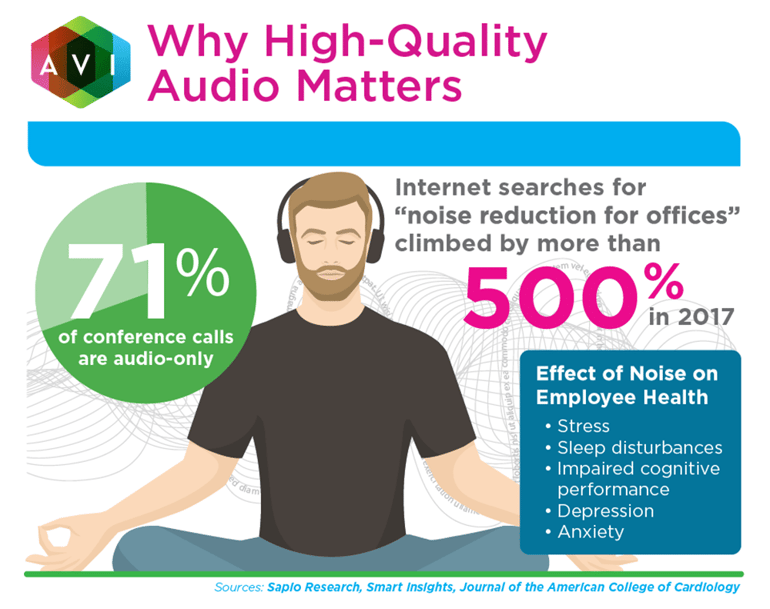Technology is always evolving from video walls to remote collaboration to interactive screens, but one thing is and will remain the same: people need to communicate.
Whether sitting side-by-side and talking face-to-face or sitting miles apart, talking over video conference, clear audio is key to effective and efficient communication in any setting, in any industry.

Why Audio Matters
Clear and reliable audio is necessary for successful communication within your organization and is also critical to presenting an image of competence to clients, customers, and others on the outside. Here are several scenarios in which your audio solutions can make or break you.
Scenario: Your company is hosting a large web conference for current and potential customers.
Why Audio Matters: Put yourself in a potential customer’s shoes for a moment. Imagine you dial into a web conference to learn about a new product a company is releasing.
You’ve done your research. The company seems high caliber and the product could meet your needs. But when you call in, all you hear is the rustling of papers, coughing, and shuffling, while the presenter’s voice is garbled, too soft, or otherwise difficult to understand.
Chances are, you would walk away without much confidence in the company or the product they were trying to sell. Quality audiovisual systems need to both capture important sound clearly and reduce the interference of ambient noise.
Also, resist the temptation to put all your eggs in the video basket and shortchange your audio. After all, you can have a conference call without video but a video conference with no audio is useless.
Scenario: Your conference room features voice-activated meeting controls.
Why Audio Matters: Voice-activated digital assistants, which are now commonplace in homes and smartphones, are poised to make the jump into the workplace.
Applications can include scheduling conference rooms and controlling their audiovisual systems. Most of us have experienced the frustration of repeating the same question for Siri or Alexa over and over again and being misunderstood.
Now imagine trying to run a meeting with voice-activated AV solutions and having the system misunderstand you—or not hear you at all. No one wants to spend an entire meeting listening to you say, “OK, Google."
So, make sure microphones and speakers are reliable and sensitive enough to hear and transmit to you clearly.
Scenario: Your company has a large remote workforce.
Why Audio Matters: The Harvard Business Review received over 1,100 responses to a poll about remote work. The report shows that 52 percent of respondents say they work remotely at least some of the time. That number is growing too.
However, it comes with a price. According to the poll, respondents who work remotely often feel isolated or treated differently. When challenges arise, they often go on unresolved for days or weeks at a time.
Of the respondents, "Nearly half of respondents (46%) said the most successful managers checked in frequently and regularly with remote employees."
Talking is key to communication, collaboration, and unity. Poor audio solutions—such as outdated teleconferencing systems and conference room microphones—make it difficult for remote employees to hear what is going on and be heard when they wish to contribute, only increase feelings of isolation and separation.
Listen — And Hear — Your Way To Success
Companies that invest in up-to-date and relevant technology have an easier time attracting and retaining high-quality employees, especially millennials who expect a high level of flexibility and collaboration from the workplace.
But no matter the industry, a focus on the basics will ensure you can hear and be heard on your way to greater success.








